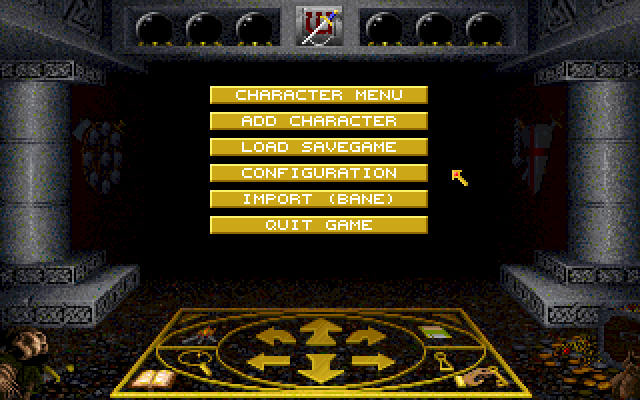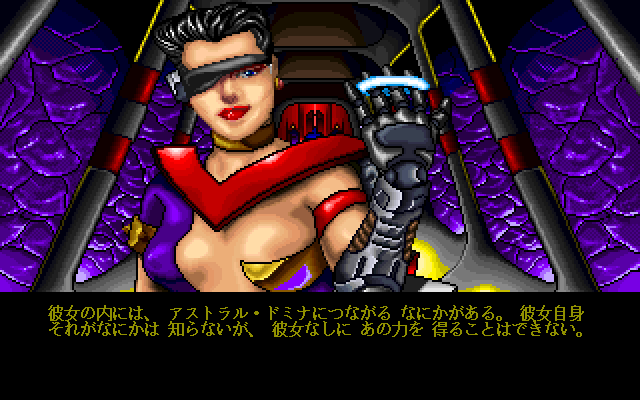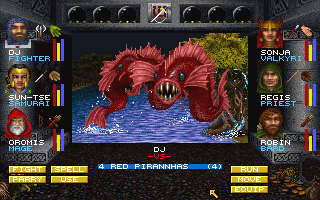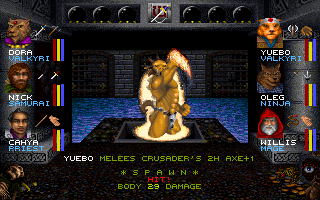Retro Replay Review
Gameplay
Wizardry: Crusaders of the Dark Savant builds on the sturdy foundation of its predecessor, offering first-person dungeon exploration and classic turn-based combat that veterans of the series will immediately recognize. The core mechanics remain familiar—with races, classes, skills, and magic schools unchanged—but the scale of exploration expands dramatically. Between sprawling dungeons, dense forest corridors, and multiple towns, you’ll find yourself constantly on the move, weighing your next steps against the agendas of rival factions.
One of the standout features is the dynamic NPC behavior. Key characters roam between locations in search of crucial items or to advance their own plots, creating a living world that rewards quick thinking and adaptability. Miss an opportunity to intercept a T’Rang scout, and you might find yourself scrambling to recover a lost artifact you needed for progression. This unpredictability ensures that no two playthroughs feel entirely the same, and keeps even seasoned role-players on alert.
Character progression is equally engaging thanks to new skills like swimming, climbing, diplomacy, and a much-heralded automap ability. Instead of static, text-only mapping, a learned Mapping skill overlays a real-time automap on the exploration screen, saving countless hours of paper mapping. Combat remains a tactical affair, with separate bonus pools for weapon, physical, and academic abilities alongside four magic schools and six elemental spheres. Skill gains through repeated use mean your party evolves organically around your playstyle.
Graphics
Visually, Crusaders of the Dark Savant remains firmly rooted in early ’90s PC and Amiga aesthetics. Dungeon corridors are rendered with crisp, tile-based textures and moody ambient lighting that evoke a palpable sense of suspense. While polygonal graphics were still years away, the game’s detailed sprite work and atmospheric color palettes create an unexpectedly immersive maze that rewards careful observation.
Towns and outdoor areas expand the visual palette, introducing lush forest backdrops and bustling settlement screens filled with animated NPCs. Though the resolution and color depth may feel dated to modern eyes, the clarity of UI elements—from health and spell menus to the automap overlay—remains impressively functional. Text descriptions accompany every encounter, ensuring that narrative and environment blend seamlessly.
Combat sequences rely on simple but effective animations, highlighting successful hits, spell effects, and enemy reactions. While flashier titles would soon overtake this style, Crusaders demonstrates how focused artistry and thoughtful design can compensate for technical limitations. In short, the graphics serve the gameplay and atmosphere, rather than overshadowing them.
Story
Picking up immediately after the events of Bane of the Cosmic Forge, you find your party deprived of the legendary Cosmic Forge by the cyborg Aletheides. Scraps of lore reveal the Forge as a key to the Astral Dominae, a universe-shaping artifact hidden on the world of Guardia. From the first moments, the stakes are cosmic, and the weight of destiny hangs over every decision.
The planet Guardia hosts a tapestry of warring races and secretive orders: the horned Umpani Federation, the sinister T’Rang aligned with the Dark Savant, and countless mercenary bands each seeking the Astral Dominae for their own ends. Depending on whether you imported your party from the previous game or started fresh, the opening shifts dramatically—dropping you into different alliances, locales, and narrative hooks. Yet regardless of your origin, you’re free to uphold or betray any faction, unlocking divergent paths and surprising consequences.
The script deftly balances high fantasy and sci-fi elements, weaving arcade-style dungeon crawls with weighty moral decisions. NPCs aren’t merely quest dispensers; they influence the world in real time, sometimes snatching vital items before you can claim them. Dialogue and diplomacy take on greater importance, rewarding patience and social skill over brute force. As alliances shift and betrayals mount, you’ll feel the push and pull of a living, breathing world striving to shape your destiny.
Overall Experience
Crusaders of the Dark Savant stands as a crowning achievement for aficionados of old-school, first-person RPGs. Its blending of sprawling exploration, rich narrative, and tactical depth creates an experience that is both challenging and endlessly rewarding. The learning curve can be steep—unexpected NPC interventions and punishing encounters may force you to rethink your approach—but overcoming these hurdles is profoundly satisfying.
Replayability shines through in the game’s branching faction loyalties and multiple entry points, ensuring that each new party build or moral choice can yield fresh surprises. The combination of skill-based progression, automapping, and diplomatic options gives you genuine freedom in how you tackle every obstacle. Whether you lean into brute-strength tactics, spell mastery, or silver-tongued negotiation, the world flexes to your vision.
While modern gamers accustomed to real-time 3D and streamlined interfaces may find aspects of the design archaic, the core experience remains compelling. For those willing to embrace its deliberate pacing and rich text descriptions, Wizardry: Crusaders of the Dark Savant offers a deep, immersive journey that stands the test of time. It’s a must-play for classic RPG enthusiasts looking to explore one of the most ambitious entries in the legendary Wizardry lineage.
 Retro Replay Retro Replay gaming reviews, news, emulation, geek stuff and more!
Retro Replay Retro Replay gaming reviews, news, emulation, geek stuff and more!









Reviews
There are no reviews yet.